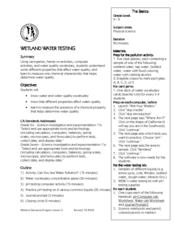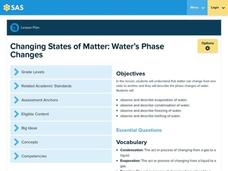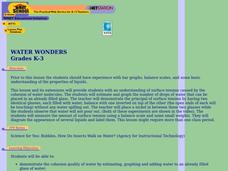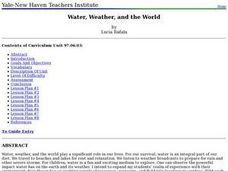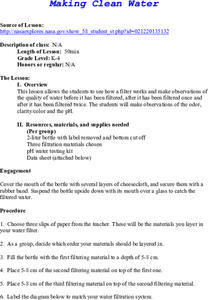Curated OER
A Little Chemistry
The molecular properties of water are the focus of this chemistry-based assignment. Multiple-choice, true-or-false, matching, and fill-in-the-chart style questions query assignees about the forces that hold the water molecule together,...
Curated OER
Wondrous Water
Learners explore the different properties of water. They experimenting with different activities, each one explaining a different property of water. Students read an article "Small, Ues, But Might: The Molecule Called Water." and then...
Curated OER
Water Vocabulary
For this water vocabulary worksheet, students explore facts about water. Students complete fifteen multiple choice questions about water and it's characteristics.
Curated OER
Stream Scanners
Young scholars investigate quality of water in a stream, lake, or pond by examining chemical, physical, and biological characteristics.
US Environmental Protection Agency
A Mock Town Meeting on a Proposed Tank Farm
Intended as a follow up to the Protecting Your Drinking Water activity, young environmentalists use their assessment of the a hypothetical town's water supply to debate the installation of underground chemical storage tanks. With the...
Curated OER
Wetland Water Testing
Students examine the different properties that affect water quality. In this pollution lesson students play a game, complete a hands on activity and computer lab.
Curated OER
Properties of Salt
Students discuss certain properties of salt and how it is used every day as well as harmful uses. They experiment with salt to see it conduct electricity, form crystals and water freezing temperature. They complete a worksheet to record...
Curated OER
Practice Sheet: Colligative Properties
In this colligative properties activity, students solve eight problems. They calculate molarity, molality and grams of substances in addition to using colligative properties to calculate solutions.
Curated OER
Water and Ice
Students make observations of ice as it melts. In this phase change lesson, students observe ice as it melts in a cup. They discuss their observations and place the cup of water into a freezer to change it back into ice.
Curated OER
Water Cycle
Third graders define and discuss evaporation, precipitation, condensation, and collection, color web pages to illustrate Water Cycle book, listen to stories about Water Cycle, play trivia game to demonstrate knowledge of what they...
Pennsylvania Department of Education
Changing States of Matter: Water’s Phase Changes
Third graders observe the properties of water and in its different states. For this states of matter lesson, 3rd graders view a video, read The Magic School Bus at the Waterworks and experiment with freezing, melting and boiling water to...
Curated OER
Colligative Properties and Chemical Equilibria
In this colligative properties and chemical equilibria worksheet, students answer twenty questions including ranking solutions base on their colligative properties and determining what must happen to a reaction to reach equilibrium.
Curated OER
Water Cycle Bag
Students enclose water in an airtight bag and leave it in a warm area to view the water cycle. In this water cycle lesson plan, students observe evaporation, condensation, and precipitation. They then discuss what they learned about the...
Curated OER
Geography: Water, Water Everywhere
Students discuss flooding and its causes. They view a Powerpoint presentation about floods and prevention methods. After creating a model with clay and pans, they investigate river behavior in various terrains with different amounts of...
Curated OER
Water Cycle
Ninth graders explore ways water moves through various reservoirs on Earth, examine how human activities change water cycle, investigate substances present in water that indicate human activity, and discuss how understanding water cycle...
Curated OER
Water Wonders
Young scholars experiment with the cohesion of water molecules. In this surface tension lesson, students estimate how many drops of water a full glass can take before overflowing. They watch a video that explains water molecules.
Curated OER
Water, Weather, and the World
Students in a special education classroom examine the role of weather and water in their lives. Each day, they add a symbol for the weather outside and identify the proper activities for the weather on that day. In groups, they...
Curated OER
Making Clean Water
Students examine water samples assess the quality of each sample by examining the color/clarity, smell, pH, etc. of each Then they filter the water samples once and assess water quality a second time. finally they filter the samples a...
Curated OER
Water Reflections:
Students analyze data from monitoring activities . They summarize, post, and present the data from activities. They tell others in the community what they've learned about local water quality.
Curated OER
Water Conservation
Students explore types of water reserves. In this water conservation instructional activity, students brainstorm ways water are used in their homes. Students use a graduated cylinder to simulate the amount of water on Earth and the...
American Chemical Society
Mysterious M&M's
The first in a six-lesson mini unit, all using M&Ms® candies, this physical science activity gets kids to observe a single piece and discover what happens when it is placed in a plate of water. The activity can be used to introduce...
American Chemical Society
Evaporation
This is one in several lessons that explore the relationship between temperature and phase changes of water. After some discussion, elementary physical scientists place wet paper toweling on a hot and a room-temperature water bag and...
American Chemical Society
From Gas to Liquid to Solid
From gas to liquid condensation to solid frost, water undergoes phase changes before students' eyes! Using ice, salt, water, and a metal can, they set up an investigation that can be used in a physical science setting, or as part of a...
American Chemical Society
Solubility Test
Make sure to consult the teacher's handbook, Inquiry in Action - Investigating Matter Through Inquiry, for two demonstrations that can be done to introduce solubility and measuring crystal mass before having the class conduct this...







